Narrabeen Fire Brigade Celebrates 100th anniversary + A few Extra insights into local fires and brigade formations

Fire and Rescue NSW photo, February 12, 2020.
On February 3rd 1920 Narrabeen Fire Brigade's first station was officially opened. The Brigade was appointed from February 1st but it wasn't until 3rd that the station officially became operational. The original station was a temporary portable premises on Devitt Street, a timber garage which cost £100 to build and was officially opened on January 27, 1920. The brigade would occupy this site until their new station opened in 1931.
On Wednesday this week, February 12th 2020, James Griffin MP, Member for Manly represented the Government and the Minister for Police and Emergency Services, The Hon. David Elliot MP, to pay respects and commemorate the occasion. Mayor Michael Regan also attended the festivities, which included unveiling a plaque to mark the Brigades service.
Mr. Griffin thanked Fire and Rescue NSW Station 068 Narrabeen for their recent service in the firestorms that went through the South Coast of New South Wales.
Most recently the Brigade was part of the whole of services response to the storms in our area over last weekend.
A message from the Deputy Commissioner Jeremy Fewtrell
Fire and Rescue NSW, February 10, 2020:
A huge thank you to all our staff for a massive effort during this weekends wild weather. On Sunday we responded to more than 5000 incidents, making it our busiest day on record ever. To put this into perspective this is double some of our busiest bushfire days this season.
We took more than 16,000 triple zero calls over the weekend, attended more than 200 fires, more than 100 rescues, almost 400 storm related incidents and over 60 HAZMAT incidents.
This was an incredible effort by all our staff on the ground, in our communications centres and all other support staff.
Some photos from Wednesday:
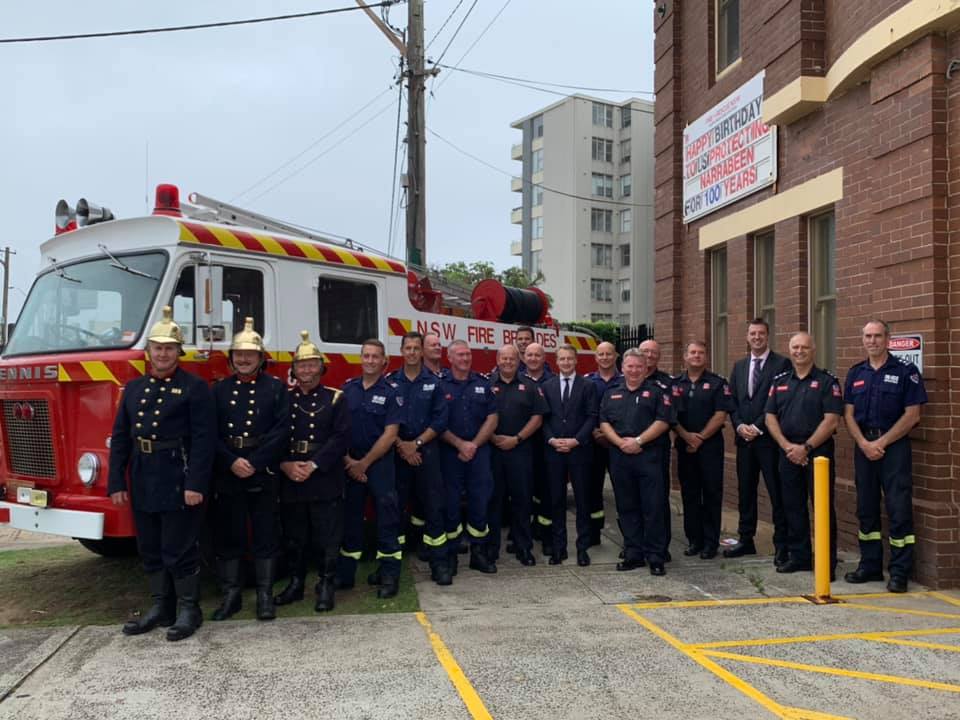
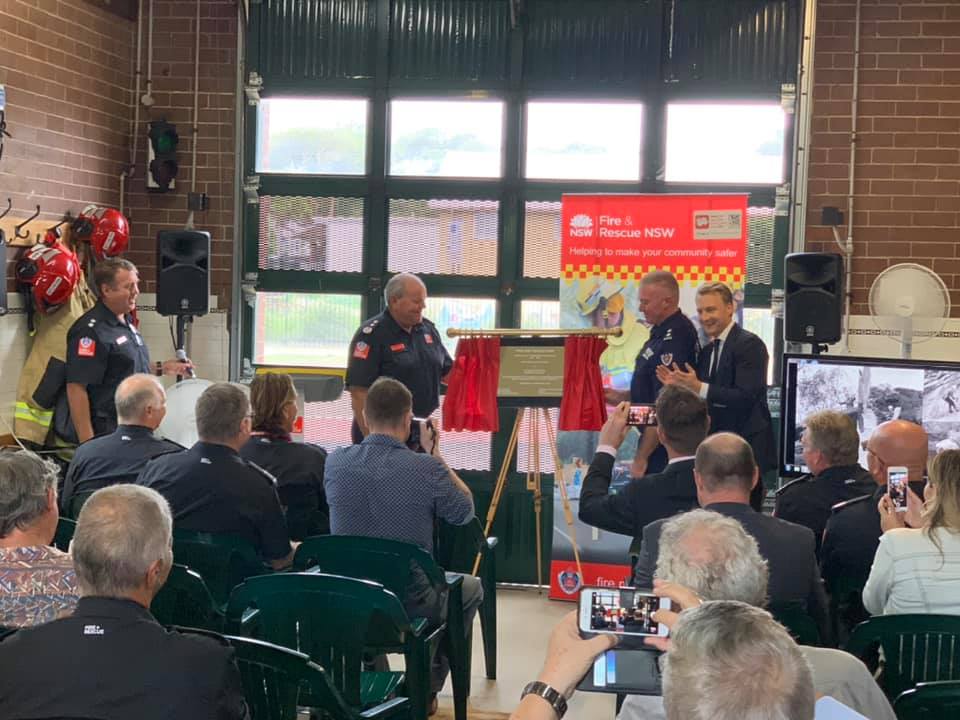
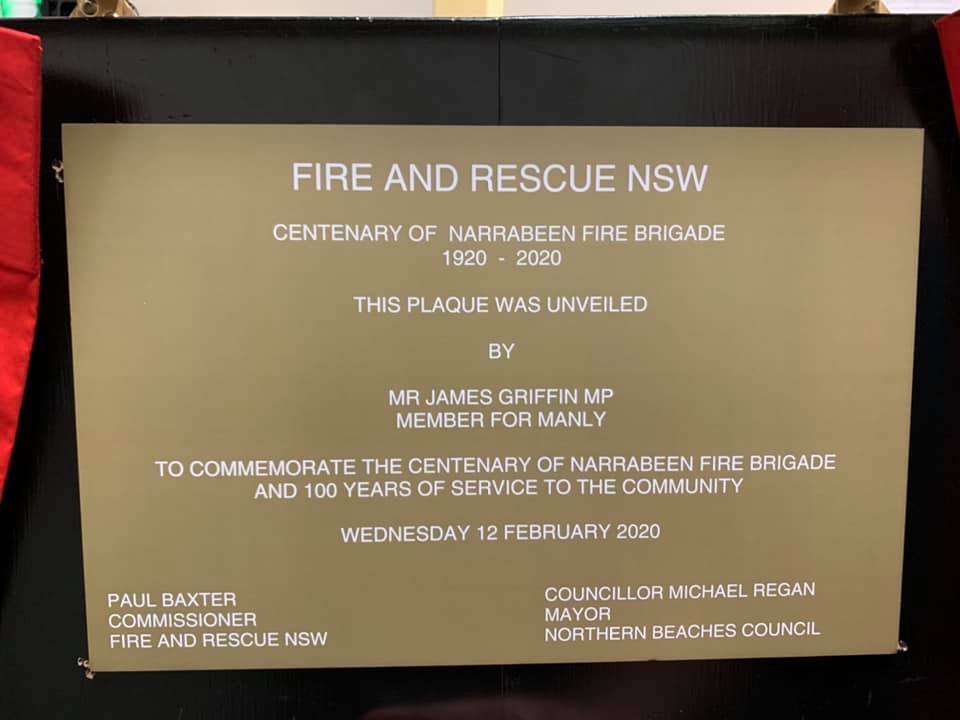
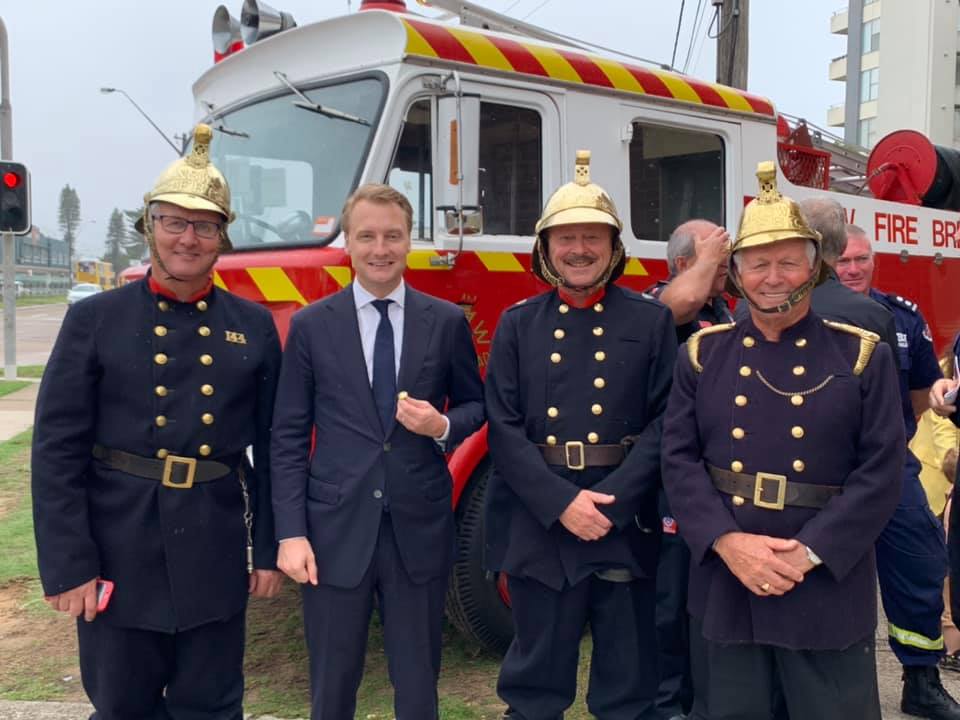
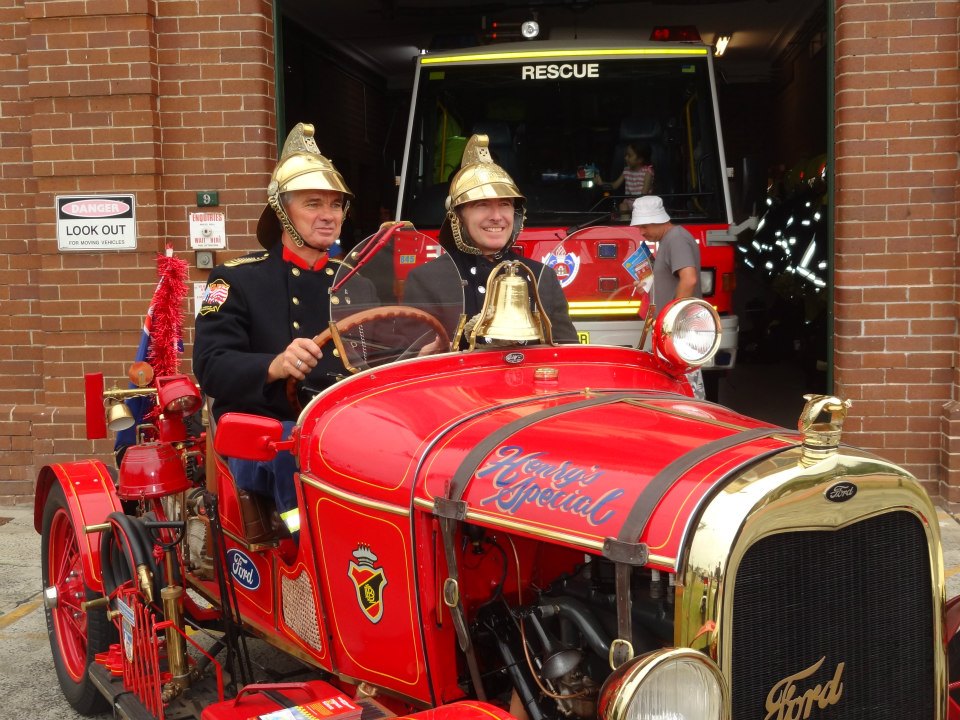
Fire and Rescue NSW Station 068 Narrabeen, welcomed Firefighters past and present all joined together to celebrate the stations long standing service to the community. The Museum of Fire's Heritage team were also in Narrabeen this week to celebrate the centenary of Narrabeen Fire Brigade. To commemorate the occasion the museum's heritage team have produced this colour book, which has that original shed on its cover:
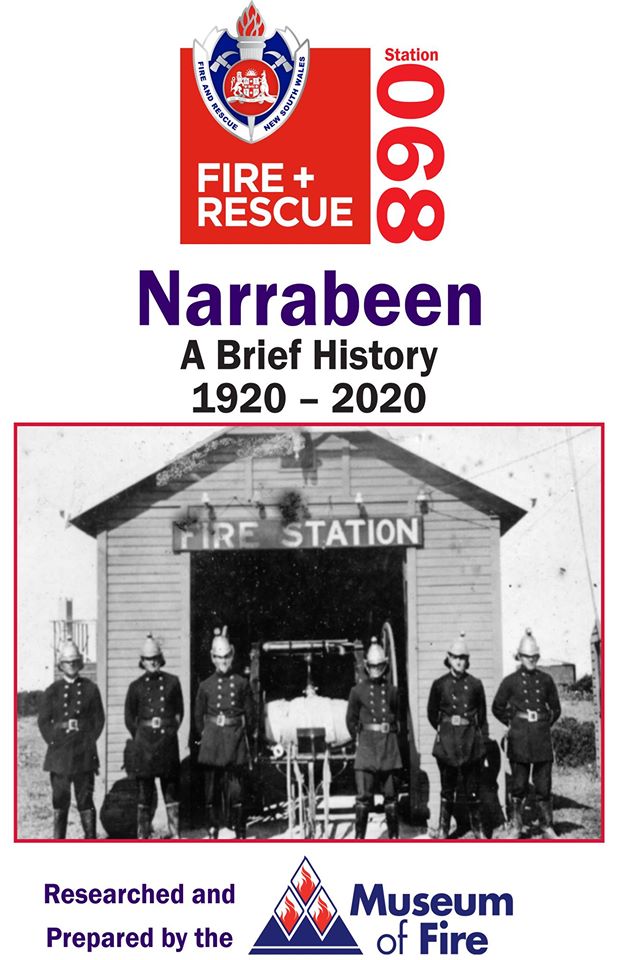
Historical insights into the formation of the Narrabeen Fire Brigade and other fires and Brigades in our area, show the frequency of fires in a rural-holiday landscape predominated by structures built from timber. This first 'crew' was a volunteer Fire Brigade, staffed by six men including the Captain. [1] The Brigade was initially a part of the Narrabeen Fire District, but on November 1st 1923 it was incorporated into the Sydney Fire District. That first Station was situated in a “Sexton Simplex building" on the corner of Ocean and Devitt Street, Narrabeen.
FIRE AT NARRABEEN
Volunteer Brigade's First Job
A volunteer fire brigade was formally Inaugurated last week at Narrabeen, and early this morning the members had their first job, at the garage of Mrs. Mary Hyde in Pittwater road.
About half-past 3 Mrs. Hyde was awakened by the smell of smoke and looking out saw flames coming from the garage. She ran out and rang the fire bell, and in a few minutes the new firemen were on the scene.
A motor car and three motor 'buses were in the garage. these were severely damaged before they were run into the road, and the flames extinguished. The garage and residence were slightly damaged.
The residence and cars were insured in the Atlas Insurance company for £900 each and the garage for £170. FIRE AT NARRABEEN (1920, February 16). Evening News (Sydney, NSW : 1869 - 1931), p. 3. Retrieved from http://nla.gov.au/nla.news-article115873678
Mary Hyde had earlier been convicted of selling 'sly grog' in Narrabeen:
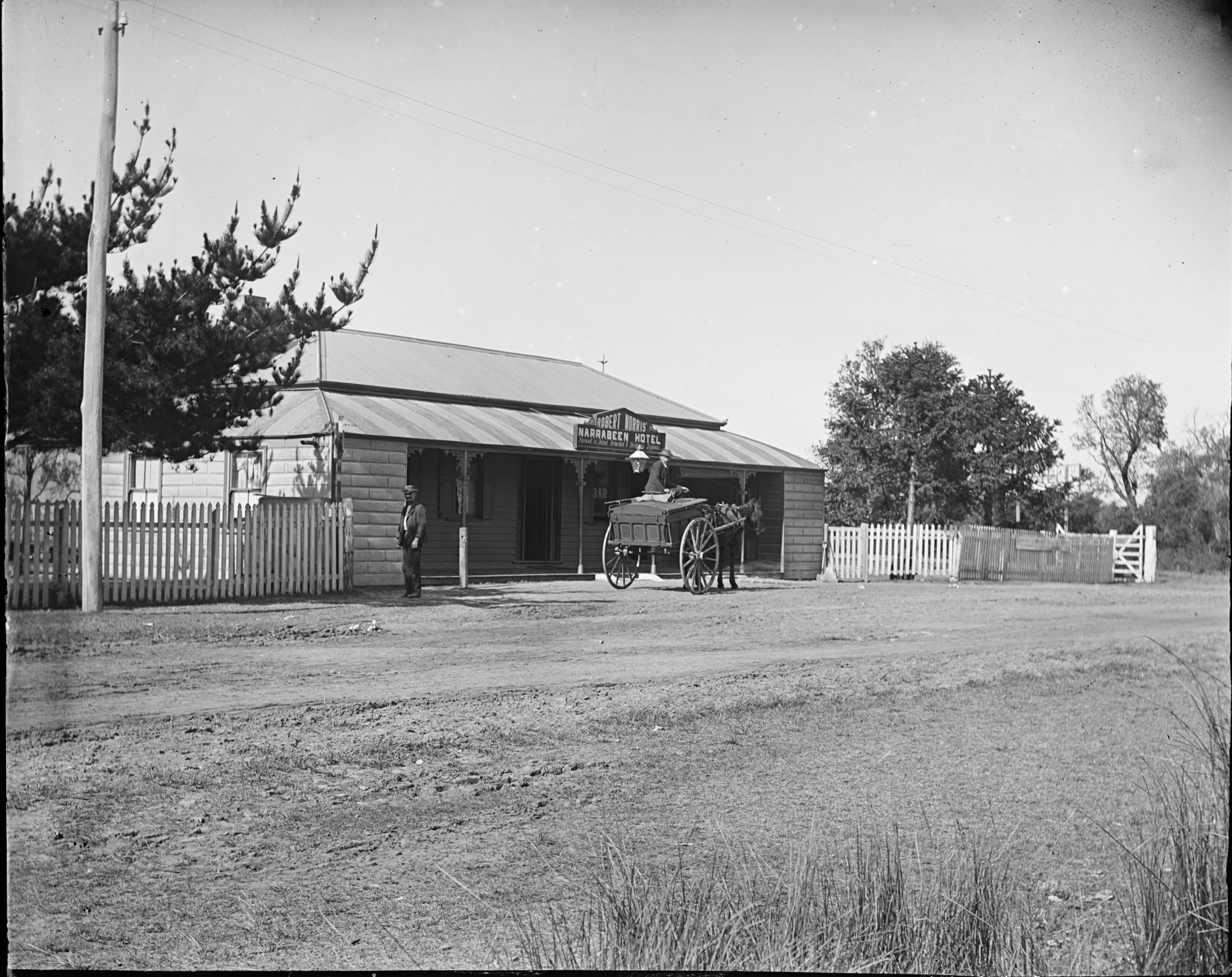
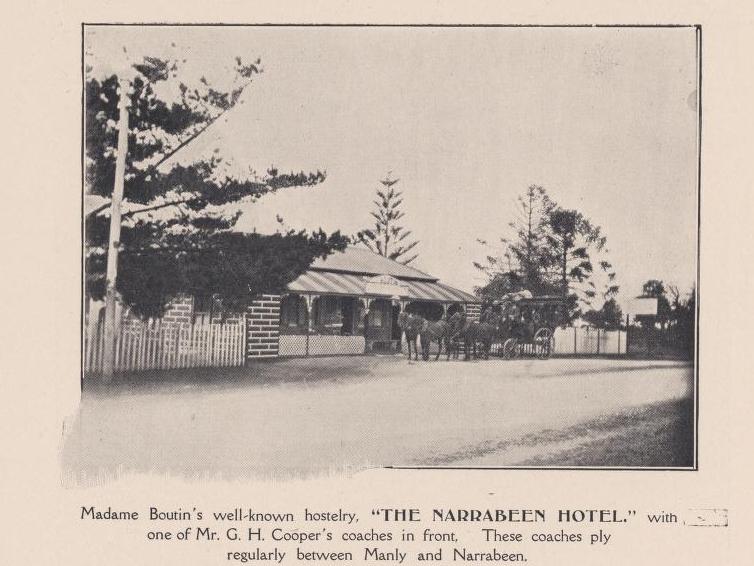
Narrabeen Lakes Estate, 1906 / Arthur Rickard & Co. Ltd Auctioneers. 1906. MAP Folder 114, LFSP 1695 (Copy 1). Part 2. (sales brochure) Image No.: 22704748, courtesy National Library of Australia.


1907 plans by Charles Jakin- signed off 10.5.1907. Courtesy State Library of NSW.
In 1911 Charlotte transferred the licence to a man named Bacon, one of those whom added his name to her second last In Memorium to Battistella almost twenty years later. Charlotte was advertising a Green African Parrot next to the Narrabeen Hotel in 1920 but soon after George’s death she began buying other Hotel licenses closer to town; The Imperial in Alfred Street North Sydney and the Flagstaff in Princes Street, The Rocks in 1923 and 1924. One of these changed license hands less then six months later.
The Narrabeen hotel fire wasn't the only property Charlotte lost at Narrabeen:
Fire at Narrabeen
A six-roomed weatherboard cottage in Lagoon-street, Narrabeen. was destroyed by fire last night. The origin of the outbreak is unknown. The cottage was owned by Madam Bouten, and occupied by Mrs. Elliott. Fire at Narrabeen (1924, June 15). Sunday Times (Sydney, NSW : 1895 - 1930), p. 7. Retrieved from http://nla.gov.au/nla.news-article128140930
BROCK'S MANSION BURNED.
BIG BLAZE AT MONA VALE. beautiful landmark destroyed.
Damage estimated at £12,000.
No fire- fighting appliances available.
"La Corniche," a mansion at Mona Vale, which occupied a commanding position on the road between Manly and Newport, was destroyed by fire early this morning. Flames were discovered at 10 minutes to 1. At half-past 2 only portions of the walls, and they rickety, were standing.
The building was palatial In Its dimensions and appointments, and contained in all 38 rooms, 28 of which were bedrooms. It was originally designed for The Oaks Polo Club, and was built by Mr. G. S. Brock at a cost which has been set down at £32,000. Before the building was completed, however, it was acquired by Mr. Arthur Rickard, who brought It up to date and then let It to M. and Mme. Rainaud, at one time chef to Sir Harry Rawson. Instead of being used as a polo club it became a fashionable boarding-house, and on account of its situation and its surroundings, including surfing and golf, it became exceedingly popular. There were 30 boarders in the place at the time of the fire.
The fire started in the large dining hall, and was discovered before it had a very strong hold of the room, but not in time to be beaten out. There was a hue and cry raised throughout the building, and boarders were running to and fro to ascertain the extent of, their danger and the possibilities of saving their effects. The flames spread with great rapidity, but happily not In the direction of the staircase, and many of the people were, therefore, able to dash about and get their property outside.
Those on the second and third floors, however, did not take the risk which running up and down the stairs involved, and threw most of their belongings out of the windows. In ten minutes the flames -had begun to light up the hills on either side, and to throw long reflections out to sea. The boarders were all out of the building by this time, and the menfolk were assisting the staff (numbering 20) to remove the furniture. They continued in this until the flames drove them back, and were successful in getting out a piano and other big stuff. But what was saved was a mere fraction of what was lost.
All that the people could do was to stand by and watch. There was water— the sea could be heard roaring in to shore all the time — but there was no means of pumping it into the building. No fire-fighting appliances which would avail anything were kept on the premises, there is no depot in the vicinity, and though a boarder motored to Manly post haste and reported the blaze the firemen did not go out, because they could have done nothing if they had.
There were very few incidents in connection with the fire. Everybody was got out expeditiously, and though there were several cases where ladles fainted they were never in danger. Even the pets of the house were saved, though one had a narrow escape. It was a little white pussy, and it mewed and mewed pitifully on the window sill of a room from which smoke was already issuing. One of the girls attached to the staff saw its plight and darted into the building and out again with her charge in a few seconds.
Mr. Scott Fell, who has a house in the grounds of La Corniche, provided accommodation for the boarders for the rest of the night. As bad as the consequences were they might have been worse. If the blaze, for instance, had started nearer to tho stairway than it did, it is quite possible that the escape of the boarders would have been cut off, and the only exit would have been through the windows, a course . of action which would practically have endangered limbs if not life. Then, again, the wind was blowing out to sea. Had it blown from the sea, it is not unlikely that two cottages and the Casino, nearer the roadway, would have gone, while the motor garage, where four motor-cars were kept, would almost certainly have been gutted.
The most remarkable circumstance in connection with the fire was associated with the telephone. When the blaze was found to be so serious Mr. A. Davis tore the 'phone from the wall and carried it outside. Later in the morning an electrician fitted it up on to the fence— the only piece of the fence which escaped tho flames— and a trial showed that though the wires had been through the heat of the flames, the 'phone was still in order, and the Manly exchange could be distinctly heard. The boarders relished the good fortune, because it enabled them to send reassuring messages to their friends.
Mr. Rickard stated this morning that the building and furniture was insured in the New Zealand Insurance Co. for £6000, and that he was therefore a fairly heavy loser, seeing that his estimate of the value of the building was £10,000. The furniture was valued at £2000. Mrs. Mueller (wife of Dr. Mueller, of Macquarie-street), Messrs. Harvey, A-. Davis Earle Hermann, Toohey, L. A. and R. V. Minnett, Lotrois, and others of the boarders, were also sufferers by the fire. Mr. Rainaud lost silver, linen, &c., to the value of £250, which was uninsured.
The origin of the fire cannot he determined, but It is believed that It was caused by a lighted match or cigar butt carelessly thrown on to the carpet in the dining-room. Mrs. Rainaud heard a noise in the dining-room, which she attributed to burglars, and on getting out of bed found the place ablaze.
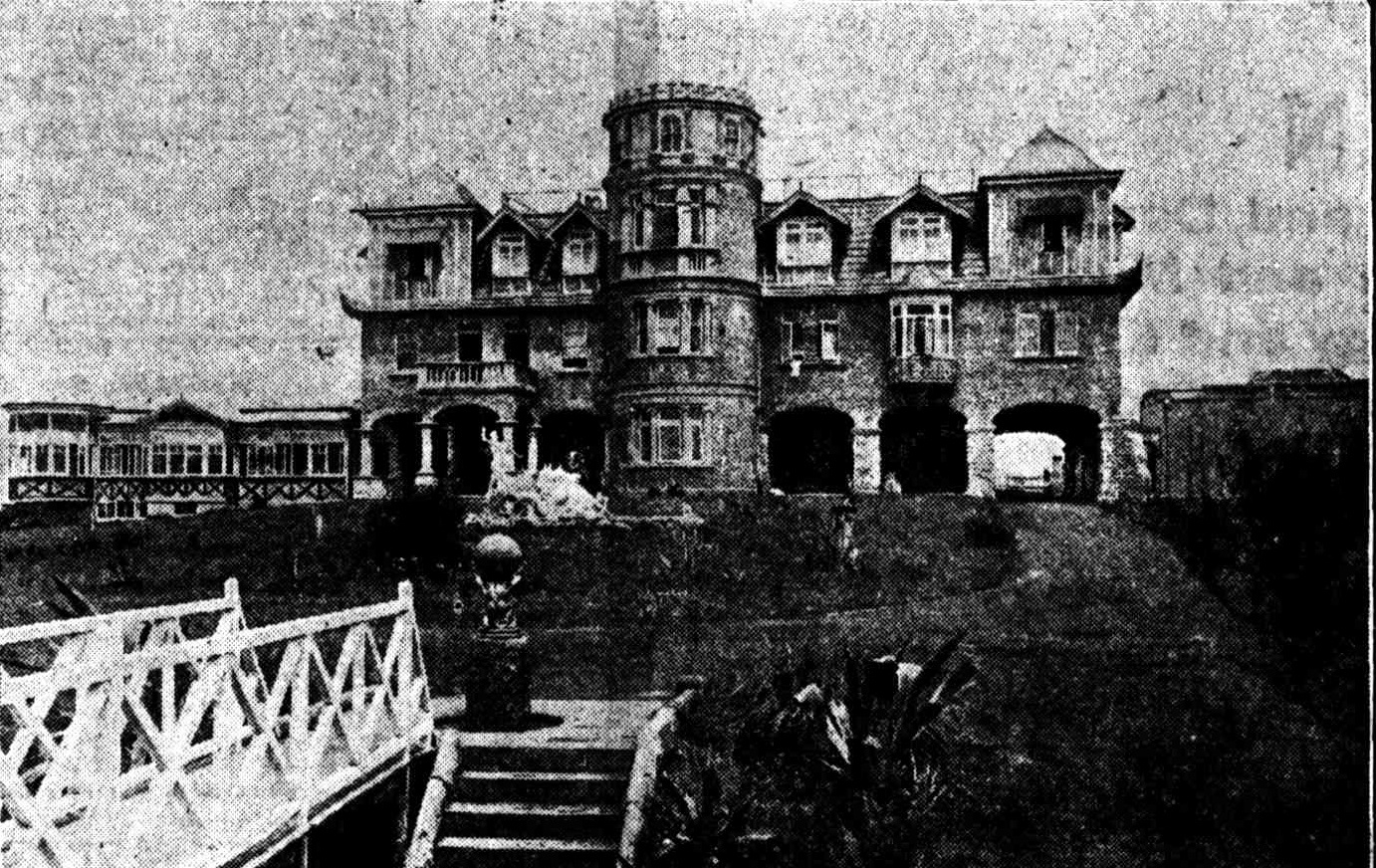
Mona Vale Hydro, the scene of a disastrous fire which occurred in the early hours of this morning. BROCK'S MANSION BURNED. (1912, January 8). The Sun (Sydney, NSW : 1910 - 1954), p. 1. Retrieved from http://nla.gov.au/nla.news-article222004219
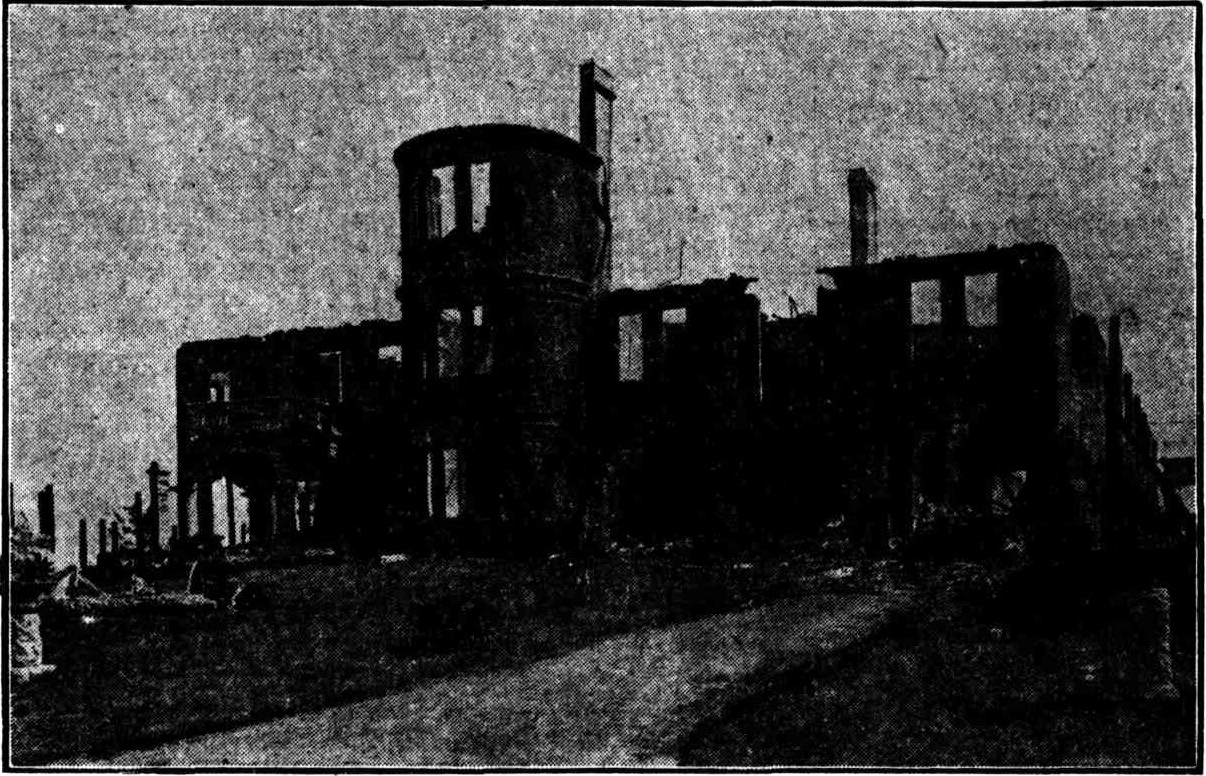
Ruins of "Brock's Mansions," at Mona Vale, destroyed by fire on Monday morning. The fate of the handsome pile of buildings is a grim finale to the financial tragedy that overtook the plucky builder, Mr. G. S . Brock, in its erection. No title (1912, January 10 - Wednesday). The Sun (Sydney, NSW : 1910 - 1954), p. 1 (FINAL EXTRA). Retrieved from http://nla.gov.au/nla.news-article222002216
A disastrous fire, which happily did not result, as might easily have been the case, in loss of life, took place at an early hour yesterday morning. It occurred in a large boarding establishment at Mona Vale, Newport, known formerly as "Brock's Mansion," and latterly as "La Corniche," which was completely destroyed. The property is that of Mr. Arthur Rickard.
The cause of the fire is as yet unknown, but at about 5 minutes to 1 a.m. some of the occupants of the house were aroused to a sense of danger by a strong smell of smoke. On Investigation the fire was located In the dining-room, and it was at once seen that any efforts to check the flames would be hopeless, and the Inmates were simply got out of the house as quickly as possible. Fortunately there were no signs of panic, and In a few minutes everybody was safely outside-watching the flames eating up the large building with a blaze that Illuminated the landscape for a considerable distance.
Owing to the inaccessibility of the locality no fire-engines, or, indeed, means of any water for fighting the fire, were available, and soon the whole building was reduced to ruins. The place, which Is said to have cost Its builder £30,000, was Insured for £6000 In the New Zealand Insurance Company; but the loss to the present owner Is estimated at about £10,000. Something like £250 worth of books, silver, and linen was not insured at all, and was totally destroyed. The building, which was a large one, contained 37 rooms. There were about 30 boarders in the house when the outbreak occurred.
A rather pathetic history attaches to the now smouldering building. Some years ago Mr. Brock, of Enmore, a gentleman with an enterprising idea, was so struck by the beauty and natural advantages of Mona Vale district that he originated a plan to establish and conduct an elaborate tourist home and sanatorium there, similar to Medlow Bath. Mr.Brock approached the Government of the day and laid his scheme before the Minister having charge of the railway and tramway construction branch, with a view to securing tramway communication to the spot. The scheme appeared so genuine and sound that Mr. Brock was given the assurance that, if the work was commenced, the tramway would be considered. He then set to work and laid out the grounds, and brought along his building material, establishing brickworks and a saw mill.
The tramway proposal from Manly was also favourably considered, and surveyors were sent to Manly. £30,000 was spent on the building by Mr. Brock. It assumed gigantic proportions, and when nearing completion formed one of the principal landmarks along the coast. The grounds were laid out to perfection, and included a racecourse, golf-links, and polo grounds. A fine surf-bathing beach also formed part of the establishment.
The tram meanwhile was constructed only as far as North Manly, a distance of one mile. The Minister for Works, Mr. E. W. O'Sullivan, who had worked hard for the extension, left office. The non-completion of the tramway was disastrous to Mr. Brock, as the financial success of the enterprise depended largely on tramway facilities being given to the sanatorium. The premises soon changed hands, Mr. Brock being a heavy loser.
Recently the greater part of the property was put up for auction sale by Mr. Arthur Rickard and sold at a good figure. The name of the building was changed to "La Corniche," and was utilised as a boarding establishment by the proprietor, who has now sustained a great loss by the fire.
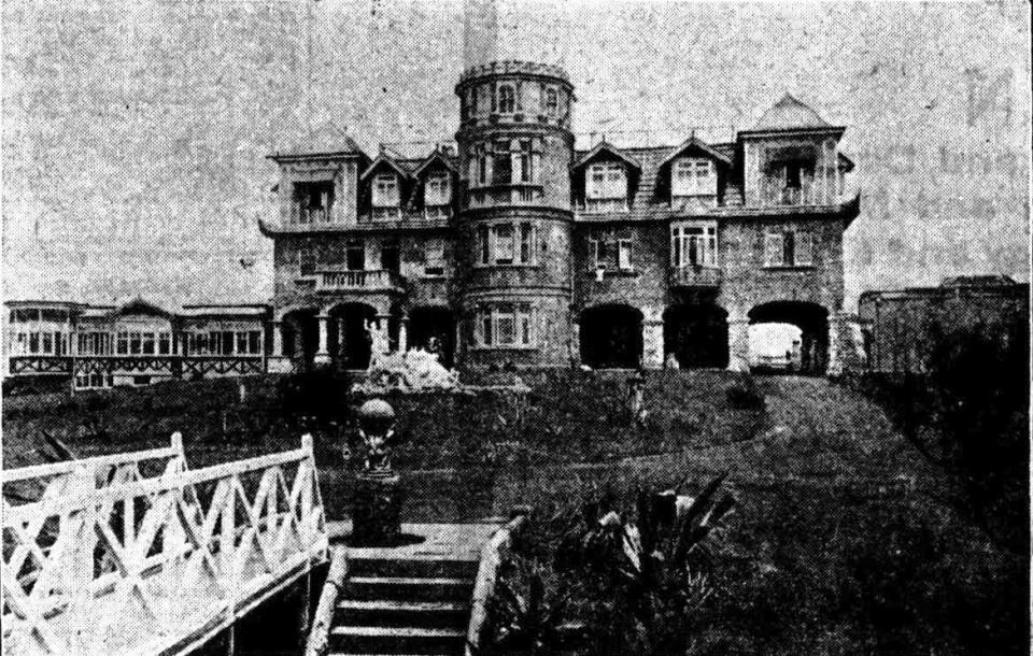
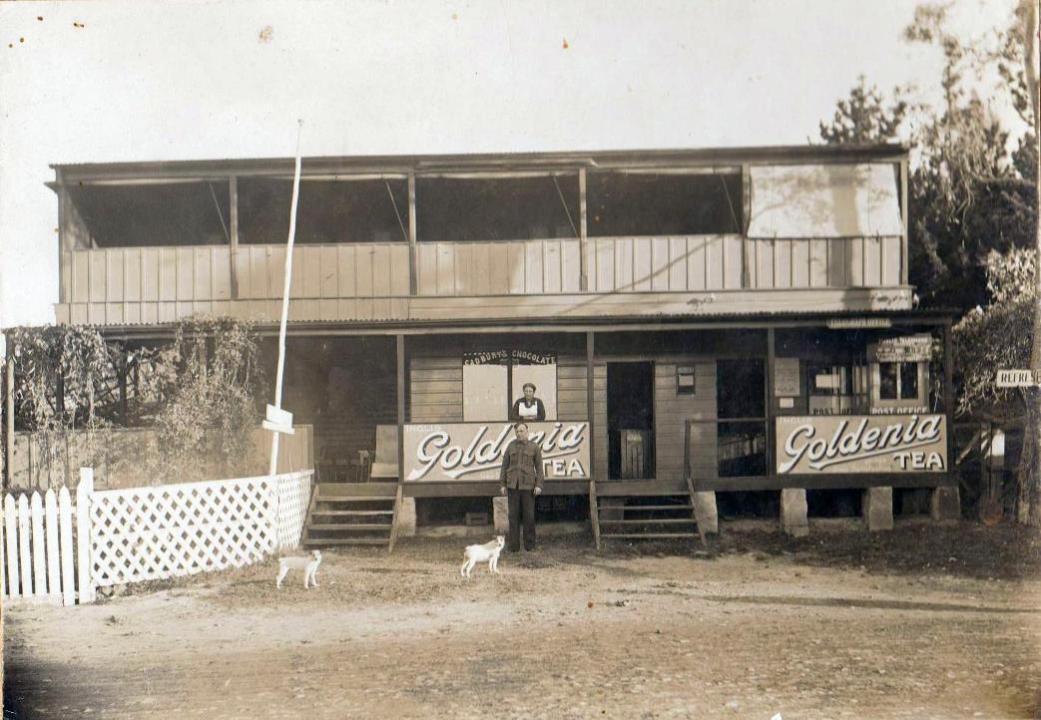
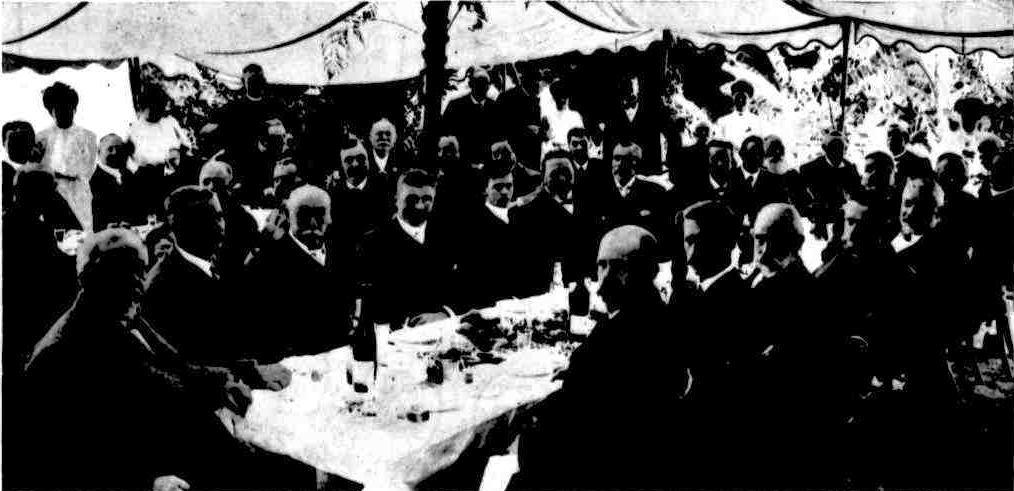
DISASTROUS FIRE. At Church Point. BUILDINGS AND BOATS DESTROYED.
A fire which broke out last night at Church Point caused extensive damage, the general store and post-office, tea-rooms, and garage, as well as a launch and several rowing boats, being destroyed. The residents of the well-known pleasure resort were unable to combat the flames, as no water supply was available.
The fire, it is stated, broke out first in Mr. H. Jensen's general store, a large wooden structure. The flames quickly devoured that building and spread to the adjoining tea-rooms. They razed this building to the ground, and enveloped a large motor garage, containing two or three cars. A motor launch, which was lying on slips at the rear of the garage, and several skiffs, which wore tied up beneath It, also caught fire. The garage and Its contents were destroyed.
Mr. Jensen, the manager of the store, tea-rooms, and garage, was spending the evening with his family at a picture theatre in Collaroy. He was not aware of the fire until he returned home at a late hour to find the buildings In a state of ruin. Mr. Jenson Is also In charge of the post-office at Church Point.
The buildings were owned by Mr. H. J. Fitzpatrick, of Lennox-street, Mosman, and were leased by him to Mr. Jensen. The boats were the property of Mr. Jensen. One of the motor cars was owned by the local mailman. The fire was discovered in peculiar circumstances. A resident of Newport, on the opposite side of the bay, noticed a brilliant glare In the direction of Church Point, and he communicated with the Mona Vale Telephone Exchange, and Inquired if any fire had been reported from that vicinity. The telephone operator got Into communication with a resident at Church Point, and this man discovered the fire. It is believed that the damage will amount to several thousands of pounds. DISASTROUS FIRE. (1928, November 22). The Sydney Morning Herald (NSW : 1842 - 1954), p. 13. Retrieved from http://nla.gov.au/nla.news-article16511092
His efforts to rebuild were delayed by a Timber Workers strike. Both The Post Office Master General and Warringah Council made several inquires during 1929 as to when this would occur, and although he had contractors to rebuild, at a cost of £2000, and furnished a drawing, Charles Frederick Wymark, filled the gap as Post Master.
IT is notified in Government Gazette of 28th December, 1928, that application has been made by Herbert James Fitzpatrick for an extension of term of his Special Leases 1924/23 and 1925/7, Land District Metropolitan, for Store, Garage, Boatshed, and Refreshment Room at Church Point, Pittwater. Objections must be lodged at the Land Board Office, Lands Department, Sydney, up to 28th January, 1929. H.H.MATHEWS, Metropolitan District Surveyor, 24th December 1928. Advertising. (1929, January 2). The Sydney Morning Herald(NSW : 1842 - 1954), p. 9. Retrieved from http://nla.gov.au/nla.news-article16520681
Records indicate that Mr. Fitzpatrick moved his family to a rural setting at this time, for work, and also for health reasons. Although he continued to have large holdings in Pittwater, particularly in the nooks he loved so much, Church Point, Elvina Bay and Scotland Island, it is Charles Wymark, only son of the wonderful Frederick Wymark, who seems to have moved into Church Point in a big way.
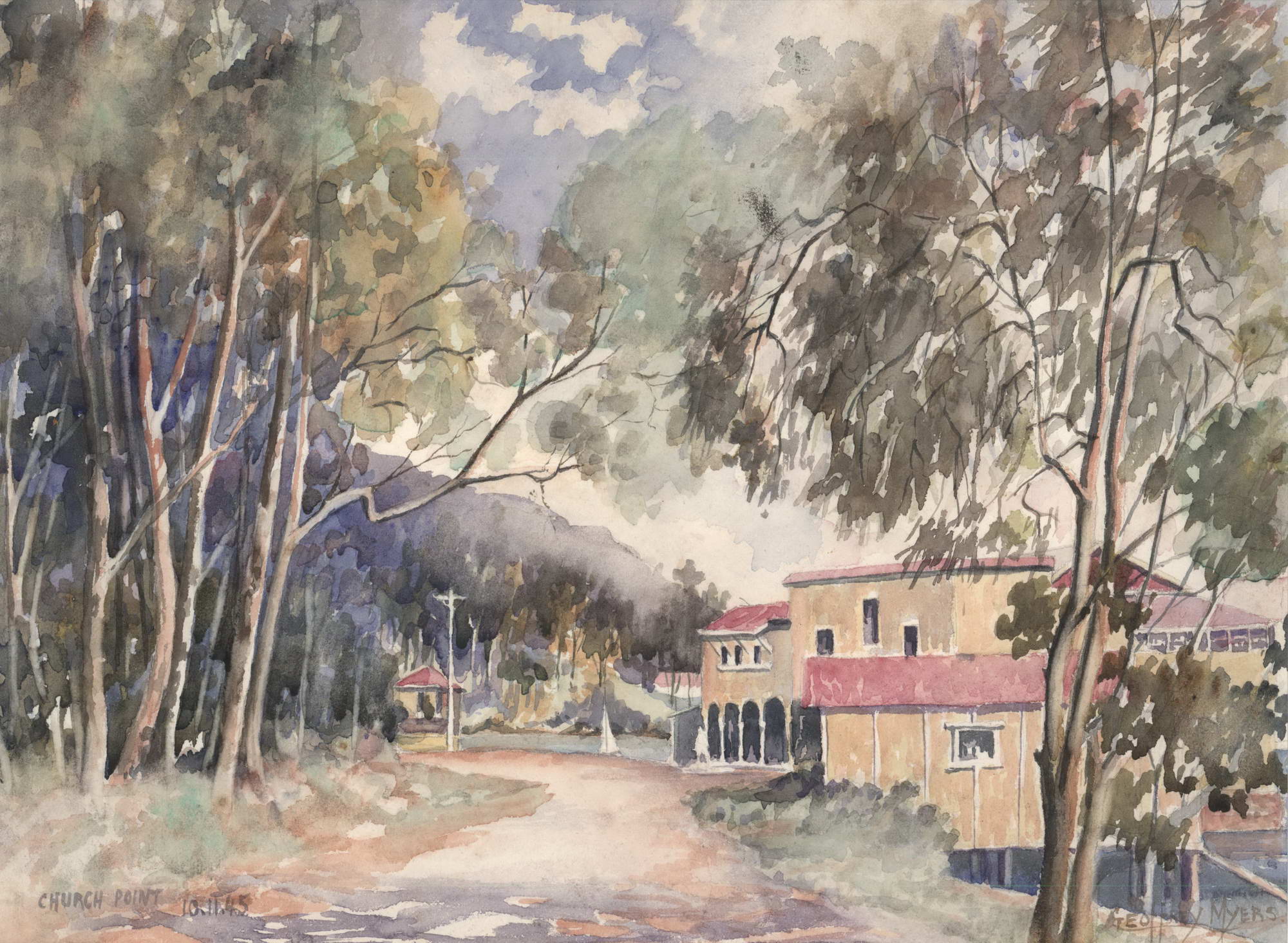
Geoffrey Myers. Church Point [Boatshed, Pittwater, NSW] 1945. Watercolour, titled, dated “10.11.45” and signed lower left to right, 26.7 x 36.7cm. Slight tears to right edge. Item #CL183-125 Price (AUD): $880.00 from: https://www.joseflebovicgallery.com/pages/books/CL183-125/geoffrey-myers/church-point-boatshed-pittwater-nsw
Another in the Bayview-Church Point area soon afterwards, and during Summer, points out the facts the Narrabeen Brigade members faced:
PITTWATER FIRE.
Mr H Alec Brown Pitt street has written to the Editor complaining of what he describes as the callousness of the Narrabeen Fire Brigade in not attending a fire which occurred at Church Point Pittwater on Friday. The fire destroyed the residence of Dr Du Maurier of Macquarie street and when the brigade was called it was stated an officer first demanded a guarantee because the fire was beyond the specified area. Dr Du Maurier gave the necessary guarantee over the telephone. Fully 20 minutes afterwards Mr Brown writes the brigade rang again to ask whether the man who had given the guarantee had the right to do so. The doctor again came to the telephone and told them that they might as well stop at home as the house had gone.
The chief officer of the New South Wales Fire Biigadcs (Mr T P H Nance) said yesterday that the question of a guarantee always arose when a fire occurred outside a reticulated fire area but where there was a chance of saving property a brigade did not hesitate to respond to a call from beyond that area. In the present case there would have been no opportunity to save the house which was a weatherboard building. It was situated seven miles from the Narrabeen station five miles beyond the area boundary and the fastest of the motors equipped with a heavy pump could not have reached the spot before the fire was beyond control.
All experts agreed that weather board houses, irrespective of their size, were destroyed by fire in 20 minutes. The time occupied in traversing the seven miles by the Narrabeen motor would nave been 21 minutes so by the time the brigade arrived there would have been nothing for the fire-men to do. A further point was that there was no water supply at the site of the fire. This was the first thing that the brigade officer determined when the call was received. On account of the low tide it would have been impracticable to pump seawater to the fire. No water whatever was available so the brigade could have done nothing. PITTWATER FIRE. (1932, February 16). The Sydney Morning Herald (NSW : 1842 - 1954), p. 10. Retrieved from http://nla.gov.au/nla.news-article28034625
The Summer of 1931/1932 had already brought fires with just a few weeks prior to the above loss:
Towns Saved From Bushfires
....
Sydney yesterday was almost encircled by bush and grass fires which swept over many hundreds of acres of land. Fire Headquarters received 53 calls, and firemen from practically every suburban station fought the flames, which in some cases went dangerously close to property. Fire-fighters from Headquarters turned out on 13 occasions to calls which proved to be false alarms. The heat was responsible for setting automatic fire-alarms in operation. The first call to a bush fire in the metropolitan area was received at 11 a.m., and from then on switch operators at Headquarters were kept busy. At one stage twelve brigades were out at the one time, and it was not until about 8 p.m. that firemen got any rest. Houses Saved Perhaps the most dangerous blaze of the dav broke out on scrub land oil Lambeth Street, Bankstown Over 30 acres were swept, and the flames advanced to within 30 yards of a row of cottages. Fire breaks saved the homes. Just when they had beaten out the fire, the Bankstown brigade was called to a three-hours' fight off River Road, East Hills, where 70 acres- were burned. Other big fires occurred at Narra-been (which was covered by a pall of smoke for most of the day), Eastwood. Hunter's Hill. Lane Cove, Cronulla, Manly, and Drummoyne. Towns Saved From Bushfires (1932, January 23). The Daily Telegraph (Sydney, NSW : 1931 - 1954), p. 5. Retrieved from http://nla.gov.au/nla.news-article246548803








Narrabeen Public School Vigoro Team 1931 - from and courtesy State Archives and Records of NSW Photo - Item 15051_1_24_a047_000179
references + a few extras
- Report of the Board of Fire Commissioners of NSW, 1920, A. R. 1921, Vol. 4, p. 969
- TROVE - National Library of Australia
- The Museum of Fire (NSW) at: www.museumoffire.net
- Charlotte Boutin
- Leon Houreaux
- The Firecracker That Closed Narrabeen Hotel by Ken Lloyd (Sava Lloyd)
- The Oaks - La Corniche, Mona Vale
- Pittwater Restaurants You Could Stay At: The Rock Lily Hotel – Mona Vale
- The First Scotland Island Cup, Trophy And Race And The Gentleman Who Loved Elvina Bay
- Pittwater Roads II: Where The Streets Have Your Name - Scotland Island
FIRE BRIGADES ACT, 1909-27.
IT is hereby notified that the Board of Fire Commissioners of New South Wales, with the consent of the Minister, hereby applies the provisions of the Fire Brigades Act, 1909-27, to the part of the Shire of Warringah within the boundaries set out in the appended description, in lieu of the parts of the Shire to which the Act previously applied, vide Government Gazettes, 5th October, 1923, 21st October, 1927, and 15th October, 1937.
Given under our Common Seal this fourth day of November, 1940.
The Common Seal of the Board of Fire Commissioners of New South Wales was hereunto affixed at a duly constituted meeting of the Board, held on the fourth day of November, 1940, in the presence of Thomas Januarius Smith and Thomas Davies Mutch and H. M. Webb, Secretary.
T. J. SMITH,
T. D. MUTCH,
* Members of the Board.
Sydney Fire District.
Description of part of Warringah Shire from Harbour to Mona Vale and Church Point.
Parishes of Manly Cove and Narrabeen, county of Cumberland and Shire of Warringah: Commencing on the shores of the South Pacific Ocean at Bungan Head at the south-east corner of lot 12 of Application No. 16,832,- and bounded thence by the southeastern boundary of that lot and the south-eastern boundary of lot 11, a line and the southern boundary of lot 9 of d.p. No. 4,579 and its prolongation south-westerly to the centre of Myola-street; thence by that centre line south-easterly to a point opposite the south-east corner of Mona Vale Estate shown on d.p. No. 9,877; thence by a line and the southern boundary of that estate and its continuation generally south-westerly to the centre of Pittwater-road; thence by the centre line of that road generally south-easterly to a point opposite the south-east corner of lot 34 shown on Roll Plan No. 599 at the town of Newport; thence by a line, the southern boundary of that lot and the southern boundaries of lots 33 to 17 inclusive generally westerly to the eastern shores of Pittwater; and bounded thence by those shores generally northwesterly to the right bank of McCarr's Creek, Church Point; thence by that right bank upwards to the southwestern boundary of portion 26; thence by that boundary and the southern boundary of portion 27 southeasterly to the western boundary of portion 28; thence by part of the north-western, the south-western and part of the south-eastern boundaries of that portion southwesterly, south-easterly and north-easterly to the southwest corner of portion 29; thence by the south-western boundary of that portion and its continuation to the centre line of Bay View road; thence by that centre line south-easterly to the south-eastern boundary of portion 19; thence by that boundary south-westerly to Cahill Creek; thence by that creek generally southwesterly to the centre of Lane Cove road; thence by the centre line of that road westerly to meet the centre line of Alan-street; thence by that centre line southerly to the northern boundary of portion 54; thence by part of that northern boundary westerly and its western boundary and its continuation southerly to the centre of Forest-road; thence by the centre line of that road easterly to the western boundary of portion 12; thence by part of the western, boundary of that portion southerly to the centre of Orchard-street; thence by that centre line easterly and the centre line of Garden-street southerly to the north-eastern boundary of Reserve No. 29,375 for Water Supply, notified 20th May, 1899; thence by a north-eastern, a northern and a- south-western boundary north-westerly, westerly and south-easterly to the centre of Merridong-road; thence by the centre line of that road southerly, the centre line of Cooleena-road easterly, the centre line of Kundibali-road southerly, the centre line of Milliwa-road easterly and the centre line of Mirrool-street and its continuation southerly to the shores of Narrabeen Lagoon; thence by a line crossing that lagoon southeasterly to the centre of Plateau-road in the parish of Manly Cove; thence by the centre line of that road southerly to the centre line of Wetherill-street; thence by the centre line of that street easterly, the centre line of Edgecliffe-street generally south-easterly, the centre line of Aubreen-street and its continuation southerly to the centre of Plateau-road aforesaid ; thence by the centre line of that road easterly and southerly to the centre of Anzac-parade; thence by the centre of that parade westerly, the centre line of Heather Parkes road south-easterly, the centre line of Orlando-road westerly, the centre line of Inman-road northerly, the centre line of Middleton-road westerly, and the centre line of Thew-parade southerly to the northern boundary of portion 1,311, parish of Manly Cove aforesaid; thence by pant of that boundary westerly and its western boundary southerly to the centre of South Creek road; thence b}r the centre of that road westerly to the centre of Alfred-road; thence by the centre line of that road southerly, south-easterly, south-westerly, again southeasterly and again south-westerly to the centre of Greenwood-avenue; thence by the centre line of that avenue westerly and the centre line of Waratah-parade southerly to the centre of May-road; thence by the centre line of that road westerly and the centre line of Consul-road southerly to the centre of Frenchs Forest road; thence by the centre line of that road and its prolongation north-westerly to a point north of the north-east corner of portion 103; thence by a line and the eastern boundary of that portion and portion 802 southerly to the south-east corner of portion 802; thence by part of the southern boundary of that portion westerly and the eastern boundary of portion 1,207 and its prolongation southerly to the centre of Old Pittwater road; thence by the centre line of that road westerly and generally southeasterly to meet the northerly prolongation of the centre line of Orara-road; thence by a line and the centre line of that road southerly and south-easterly to the centre of Kentwell-road; thence by the centre line of that road south-westerly to a point north of the north-east corner of portion 1,687; thence by a line the eastern boundary of that portion again a line crossing Curl Curl Creek, the eastern boundary of a road, the eastern boundaries of portions 1,553, 1,549 and 1,194 to the south-east corner of last mentioned portion; thence by the southern boundary of said portion 1,194 and its prolongation to the centre of Water Reserve road; thence by the centre line of that road southerly to a northern boundary of portion 1,198; thence by that boundary and its continuation and the northern boundary of Kalaui-street and its prolongation westerly to the centre of Bangaroo-street; thence by the centre line of that street generally southeasterly, and the centre line of Brook-road generally south-easterly to Burnt Bridge Creek being the boundary between the Shire of Warringah and the municipality of Manly; and thence by that boundary generally north-easterly partly along said Burnt Bridge Creek and the southern shores of Manly Lagoon to the shores of the South Pacific Ocean aforesaid; and thence by those shores generally northerly to the point of commencement. FIRE BRIGADES ACT, 1909-27. (1940, November 8). Government Gazette of the State of New South Wales (Sydney, NSW : 1901 - 2001), p. 4455. Retrieved from http://nla.gov.au/nla.news-article225110723
NSW Fire Brigades Timeline
In 1909 the Fire Brigades Act established a statewide approach to firefighting by creating the Board of Fire Commissioners NSW to oversee its implementation. This body became known as the New South Wales Fire Brigade (NSWFB).
On 1 January 2011, the NSW Fire Brigades changed its name to Fire and Rescue NSW (FRNSW). The new name more accurately reflects the wider scope of services offered to the community and proudly symbolises and supports the organisation’s vision for the future
This is an overview of organised fire protection in NSW over the last 200 years:
1820s – At this time the only form of Fire Brigade in the NSW colony was a military Brigade, consisting of soldiers trained to use firefighting appliances.
1836 – The Australian Insurance Company establishes a Fire Brigade. A number of other insurance companies follow suit. These Brigades were largely local worker volunteers who used equipment supplied by the Insurance companies (buckets, ladders and axes).
1841 – A number of businessmen come together to form the Mutual Fire Insurance Association. The following year they established their own Brigade by bringing two engines and two firefighters (Thomas Bown and Edward Harris) from England.
1851 – A number of insurance companies come together to form the Sydney Fire Establishment, also known as the Insurance Companies Fire Brigade. Bown was the Superintendent.
1854 – Andrew Torning forms the No. 1 Volunteer Company (also known as the Victoria Theatre Brigade). He then helps to create a number of other Volunteer Companies.
1855 – The NSW country town of Goulburn establishes a Fire Brigade. This is the first Brigade to be established outside Sydney. Brigades are established in Newcastle and Maitland the following year.
1874 – A disastrous fire rips through the town of Windsor, burning across 30 acres and destroying 53 buildings (of which 36 were homes). Many other country towns fearing such an incident were prompted to create their own Brigades.
1880 – After disagreements between the Volunteer Brigades and the Insurance Brigades two bodies are established: Metropolitan Association Fire Brigades and the United Volunteer Fire Brigade Association.
1884 – The Fire Brigades Act comes into effect, creating the Metropolitan Fire Brigade (MFB). This meant that all Brigades in Sydney had to register with the Board and meet certain requirements to remain active.
1888 – What is now known as City of Sydney Fire Station is opened in Castlereagh St Sydney.
1910 – The Fire Brigades Act is extended across the state and the Board of Fire Commissioners comes into being, replacing the MFB. The organisation now becomes known as the New South Wales Fire Brigade (NSWFB).
1945 – Many city stations are closed as a cost-cutting measure due to advancements in technology that reduced response times for stations to cover a wider area.
1984 – The NSWFB celebrates 100 years since the Fire Brigades Act was introduced and the establishment of a centralised firefighting body. – A new property at Chullora brings together all the transport, related sections of NSWFB.
1990 – The role of Director General replaces the Board and President.
1994 – The first Commissioner is appointed, combining the roles of Director General and Chief Officer.
2011 – The NSWFB becomes known as Fire and Rescue NSW (FRNSW) to reflect the growth and diversity of the Brigades role across the state.
2017 – The FRNSW Head Office moves from Elizabeth St, Sydney to Amarina Ave, Greenacre.
This historical account was researched and prepared by the heritage team at the Museum of Fire.
Museum of Fire
The Museum of Fire is a not-for-profit charitable organisation based in Penrith, NSW. It is the foremost Australian museum on understanding the experience of fire. Its collection, which celebrates the history of FRNSW and fire services in Australia, is of national importance. Many items are listed on the State Heritage Register.
The Museum of Fire is in a Heritage Partnership with FRNSW. It works to preserve its history and heritage through numerous conservation, heritage and research projects.
Visitors and group bookings are welcome at the Museum of Fire.
Swap cards, badges, posters, figurines and other collectible items can also be obtained from the Museum of Fire.
For further information: Museum of Fire website.
Avalon Fire Brigade
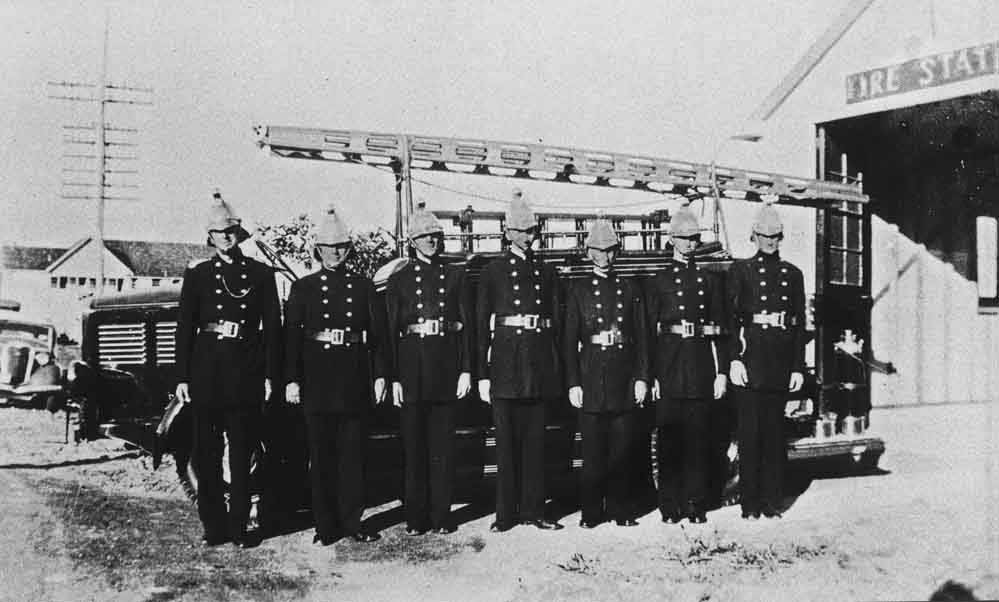
Standing in their fire-fighting gear in front of the 1936 Dennis Ace are the first seven members of the Avalon Fire Brigade (begun in 1940). From left to right are Captain Ted Hock, Tom Chegwyn, Harry Wright, Lambert-Smith, Ron Edwards, Fred Wilson and Wal Ward. The garage which housed the fire engine stood on the site now occupied by the red-brick Casa Carlos building at 50 Old Barrenjoey Road. In the background is the heritage-listed two-storey ‘Avalon Centre’ on the corner of Avalon Parade and Old Barrenjoey Road. Photo and information courtesy Geoff Searl OAM, President Avalon Beach Historical Society.
Robert Johnson: Dad and Bob were both foundation members of the Lions Club, they were both Voluntary members of the Fire Brigade in Avalon, they were both heavily involved with St Vincent De Paul when they were younger as well so there is a lot there was that idea of giving back to the community through those sorts of things from very early on.
So it was part of your upbringing?
Bob and John: Yes.
Robert: In fact, with the Fire Brigade, in its early days and because it was mostly a Volunteer Station, we actually had the bells in our store. They came back through the shop and then into the firemen's houses, so if someone had to call the fire brigade it would often be switched through to the shop first. The station did have a resident fire captain, Fred Andres, but he worked in town during the day.
Did you play with the fire bells as a little boy?
Robert: We did; there was the odd occasion where we actually accidentally set off false alarms for fires.
Anne: We still have one of the helmets; the old brass helmets. Johns' is still here.
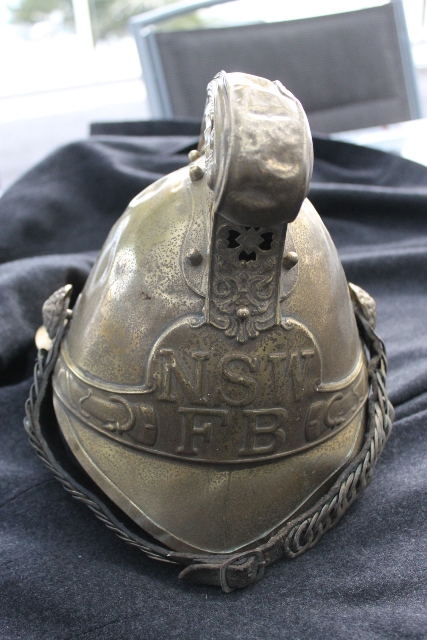
John's helmet

Narrabeen Hotel Licence Transfer Trail And Extras
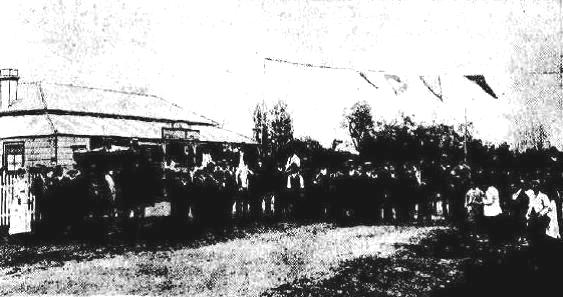
There is a stopping place at the Narrabeen Hotel, kept by Mr. Norris-a most charmingly situated hotel facing the road, the picture of which will give you a good idea of the number of travellers who frequent this place. Close to the hotel are the celebrated Narrabeen Lakes, where there is splendid fishing, shooting, and boating, to be had within a half-a-mile of the hotel. Mr. Norris makes a specialty of providing boats, camping outfits, lunches, etc., for parties coming from town to spend a day or two in this lovely district.: Narrabeen Hotel Picture: [No heading]. (1893, November 25). Illustrated Sydney News (NSW : 1853 - 1872), p. 15. Retrieved from http://nla.gov.au/nla.news-page4846491
TWO MEN DROWNED AT NARRABEEN. SWEPT OUT TO SEA WHILE SURF BATHING.
A drowning accident, by which two young married men lost their lives, occurred at Narrabeen, at 10 o'clock yesterday morning. The drowned men were Henry Thom, aged 25, of Booth-street, Balmain (a grandson of Sir Henry Parkes), and John Montagu Folkhard, aged 29, who resided with his wife and family at Gladesville. The families of the deceased have been residing at Narrabeen for about a fortnight, and on Saturday Folkhard and Thom went down to join them. The latter had only been married about two months. Yesterday morning, in company with Folkhard's father and a younger brother, they went down to the ocean beach to bathe in the surf close to the old Ocean View Hotel. Mr. Folkhard, sen., went home again shortly before 30, and the boy left the water because he was affected by cramp. He looked back in the direction of the other two men, and saw a heavy breaker go right over them. They disappeared beneath the roller, and were seen no more. The lad gave the alarm, and help was soon obtained, but it was of no avail, nothing at all could be seen of the two men. Owing to the south-east wind which had blown all night, a heavy sea was rolling in on the beach, and the strong undertow had evidently swept the bathers out with irresistible force. The police at Manly were communicated with, and all day they, with a number of friends of the drowned men, lined the beach in tho hope that the water would wash the bodies up. At night-fail, however, their search had not been rewarded with success. Folkhard was employed by Elliott Brothers, and had one child. Thom was in the Public Works Department. TWO MEN DROWNED AT NARRABEEN. (1895, January 21). The Daily Telegraph (Sydney, NSW : 1883 - 1923), p. 5. Retrieved fromhttp://nla.gov.au/nla.news-article236006881
Renewals of publicans' licenses were granted to Robert Norris, Narrabeen Hotel, Narrabeen, ...WATER POLICE LICENSING COURT. (1899, January 12). The Sydney Morning Herald (NSW : 1842 - 1954), p. 3. Retrieved from http://nla.gov.au/nla.news-article14195068
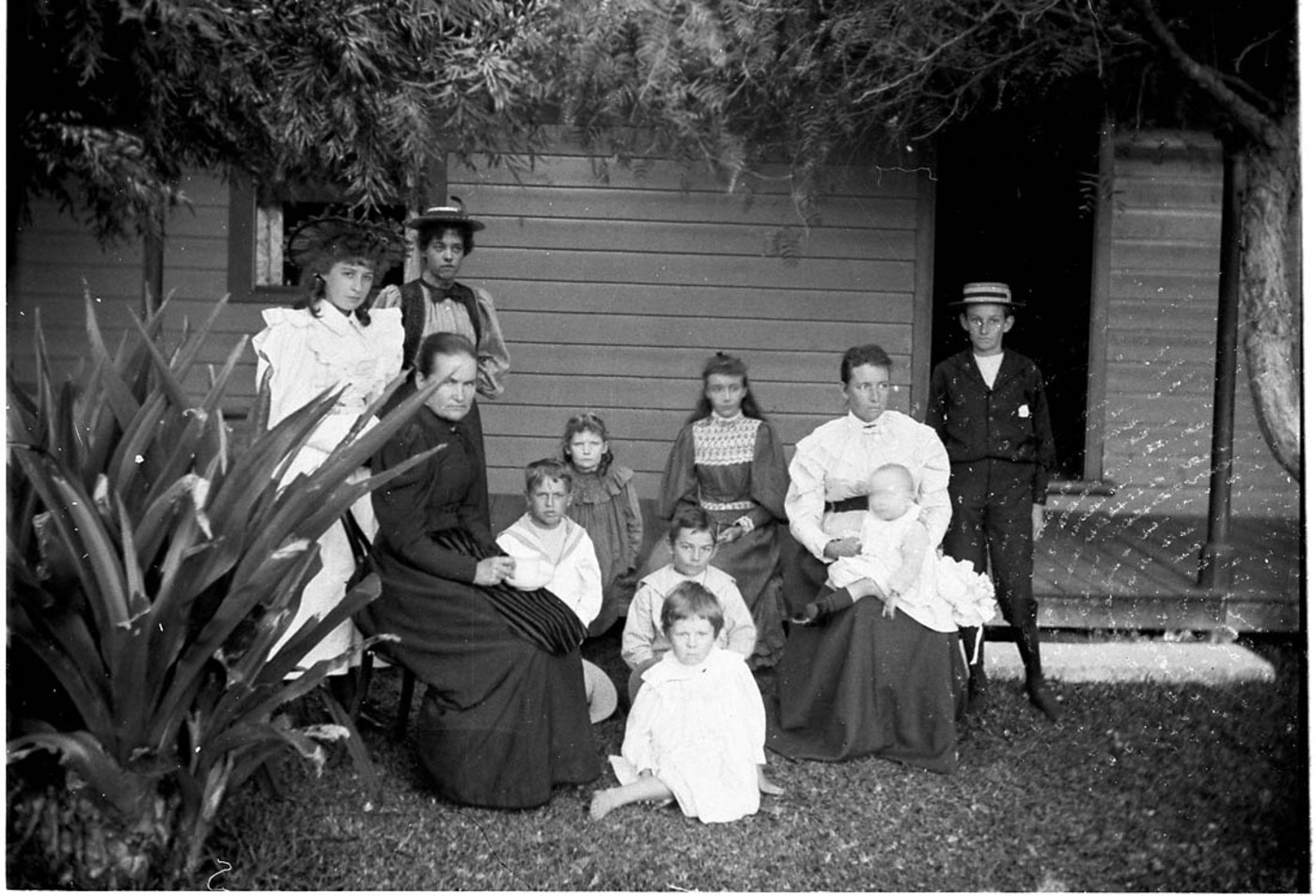
 WATER LICENSING COURT.
WATER LICENSING COURT.As can be seen above, Charlotte rebuilt. In 1911 Charlotte transferred the licence to a man named Bacon, one of those whom added his name to her second last In Memorium to Battistella almost twenty years later. The hotel seems to have been rebuilt in sections if images from those times are accurate:
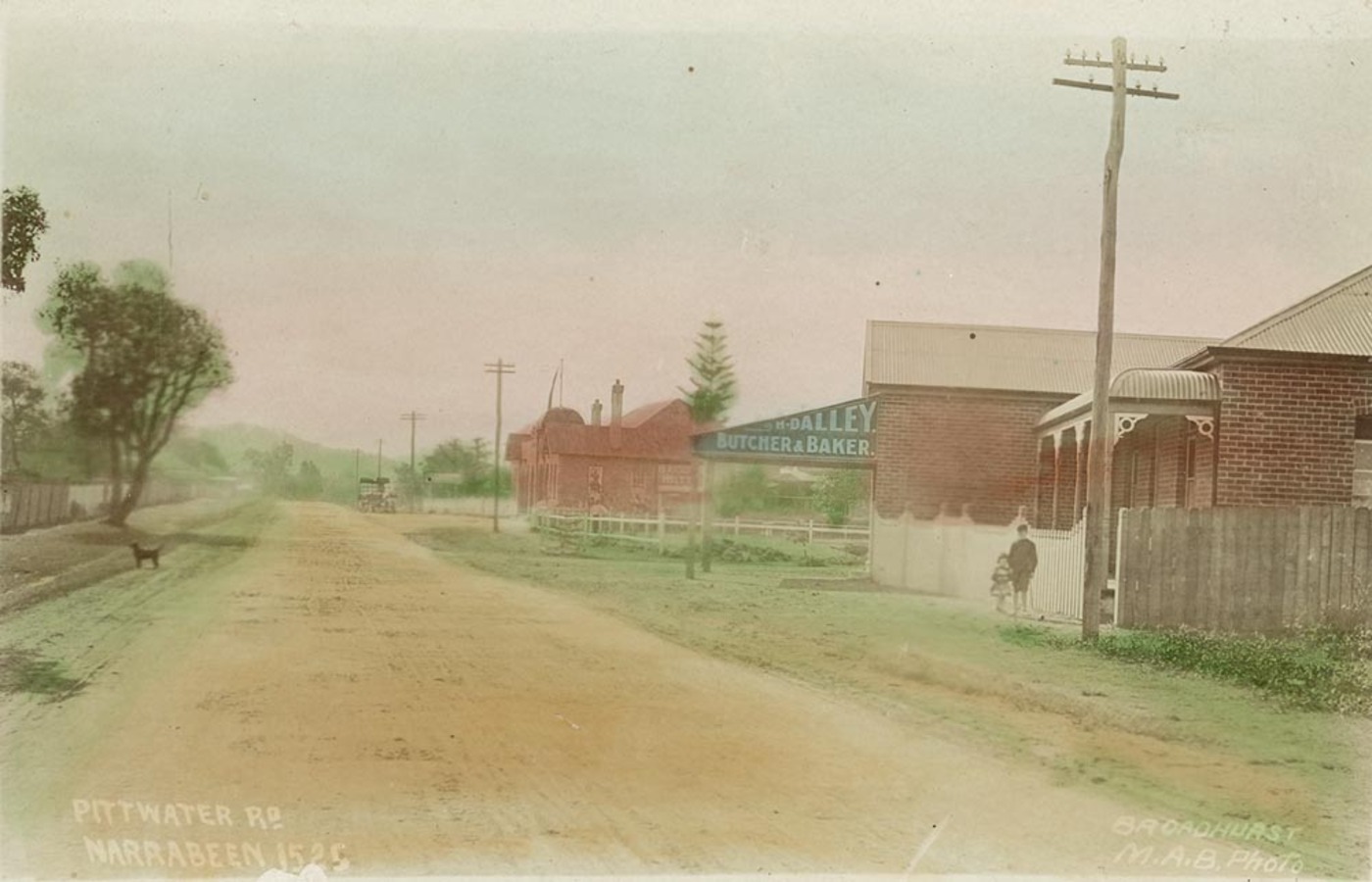
Image No.: a106069h from Scenes of Narrabeen Album ca. 1900-1927, Sydney & Ashfield : Broadhurst Post Card Publishers, courtesy State Library of NSW - the second Narrabeen Hotel may be seen with the dome a little north of the butcher's shop.
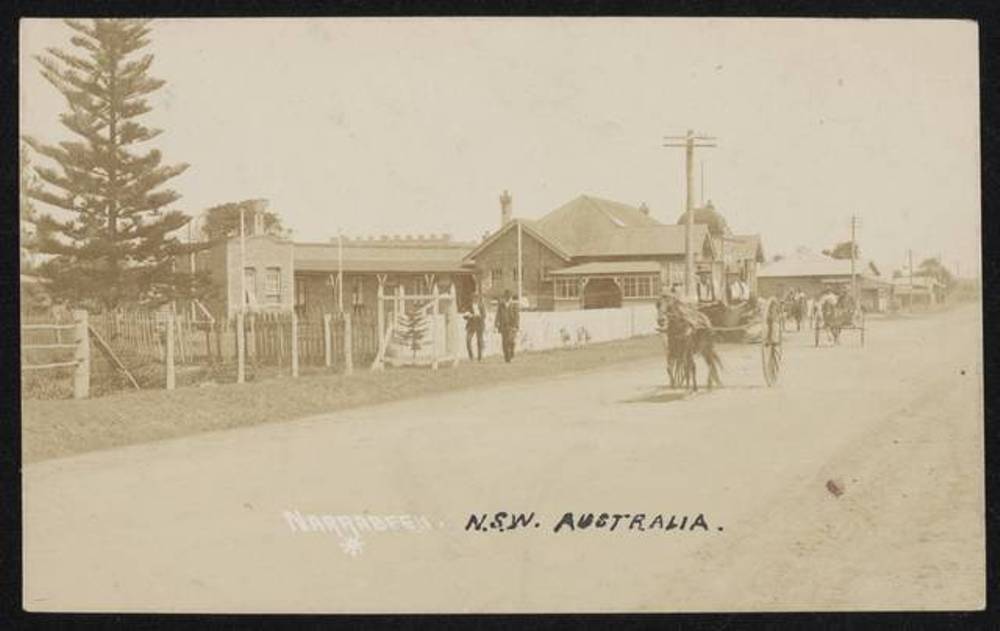
Postcard from the National Museum of Australia Collection
Charlotte was advertising a Green African Parrot next to the Narrabeen Hotel in 1920 but soon after George’s death she began buying other Hotel licenses closer to town; The Imperial in Alfred Street North Sydney and the Flagstaff in Princes Street, The Rocks in 1923 and 1924. One of these changed license hands less then six months later.
Her romantic side surfaces as the last visible note in her marriage to John C Elliott in 1924 when she must have been mature. After that she disappears apart from the annual notices for George until her death on July 26th. 1932;
BATTISTELLA -In loving memory of our dear friend Benevenuto Battistella (George of Narrabeen), who departed this life January 25, 1920.Inserted by his friends, C. Boutin, W. Porter, and C. Bacon. Family Notices. (1930, January 28). The Sydney Morning Herald (NSW : 1842 - 1954), p. 10. Retrieved from http://nla.gov.au/nla.news-article16621341
ELLIOTT-July 26 Charlotte beloved wife of John C Elliott at Randwick Private burial. Family Notices. (1932, July 30). The Sydney Morning Herald (NSW : 1842 - 1954), p. 12. Retrieved from http://nla.gov.au/nla.news-article16912266
Mr. Bacon subsequently transferred the license to:
LICENSING COURT.
The following transfers of publicans licenses were granted at Thursday's sitting of the Metropolitan Licensing Court :—From Charles Bacon to Maurice Garwood, Narrabeen Hotel, Narrabeen ; LICENSING COURT. (1913, October 25). The Sydney Morning Herald (NSW : 1842 - 1954), p. 10. Retrieved from http://nla.gov.au/nla.news-article15460592
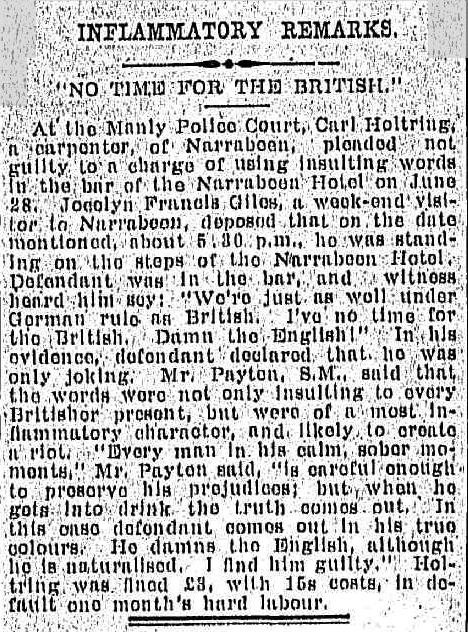
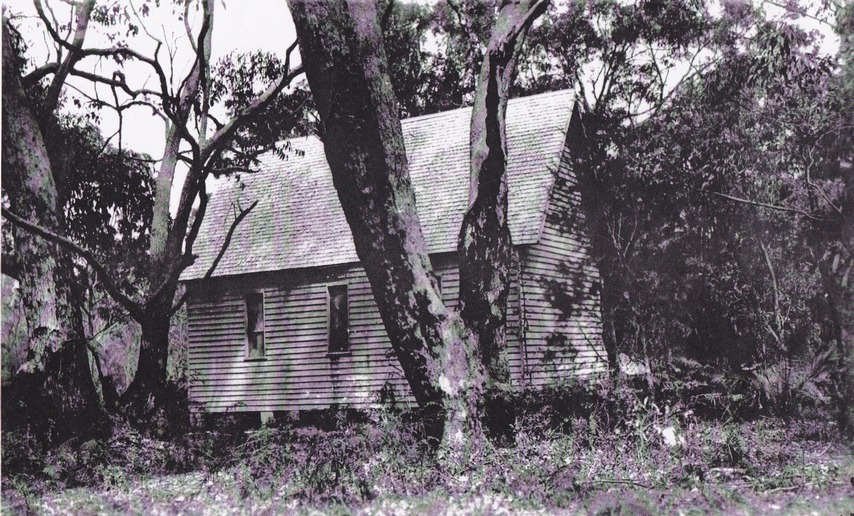
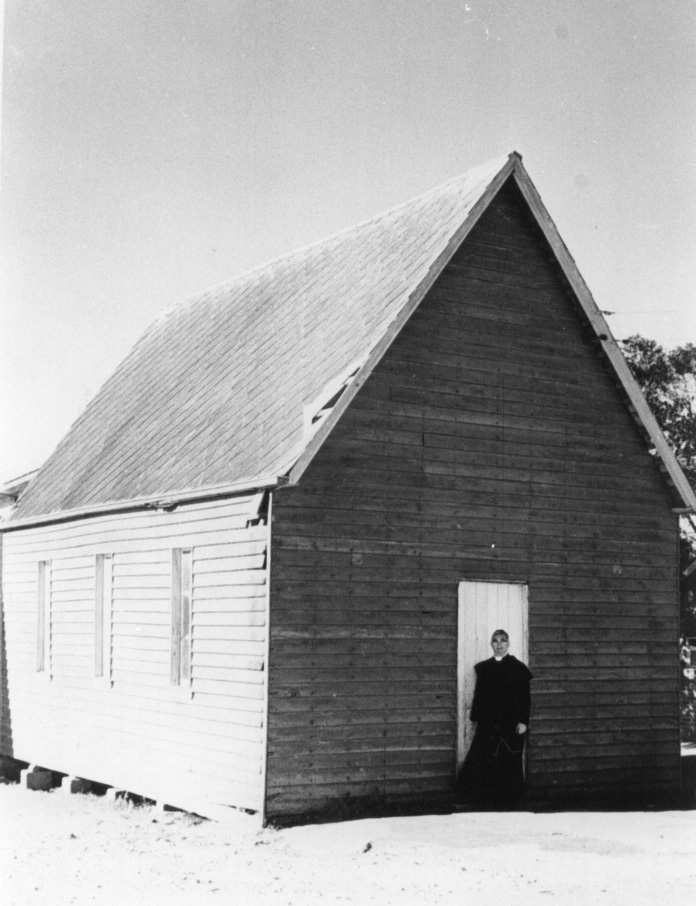
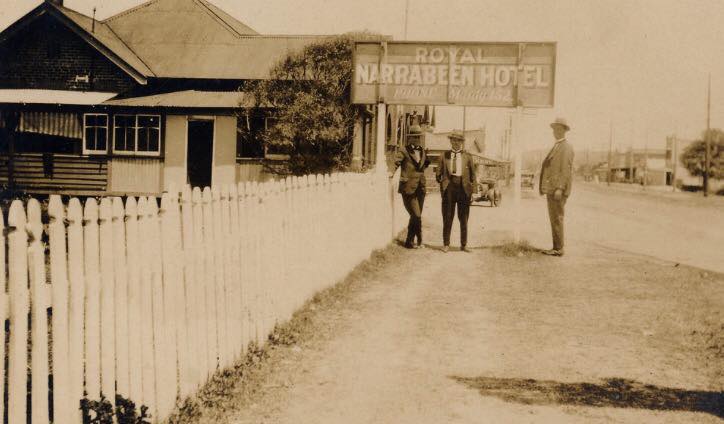
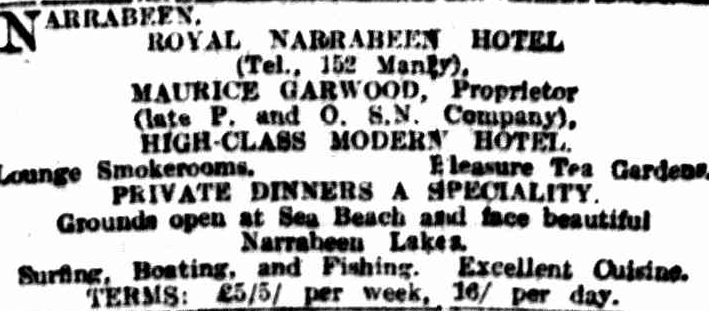
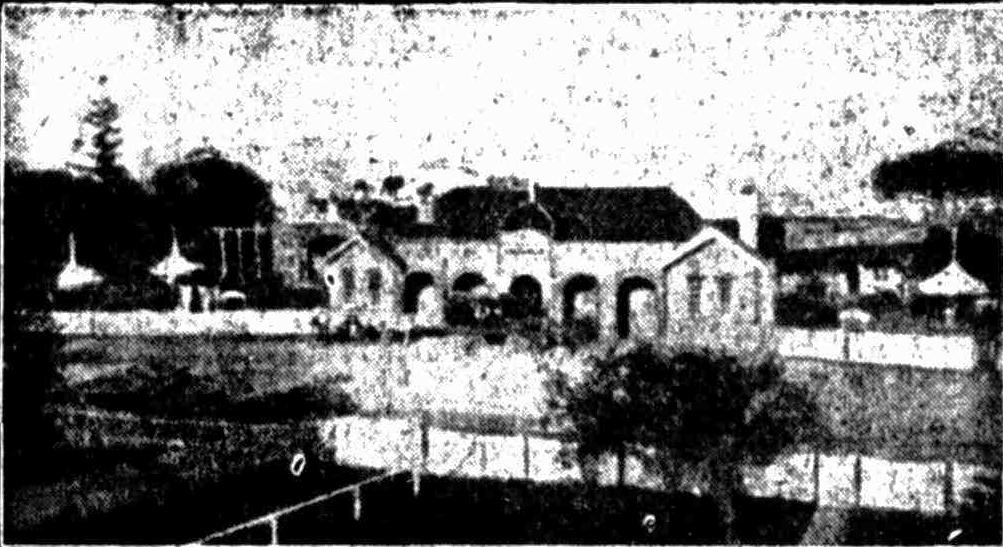
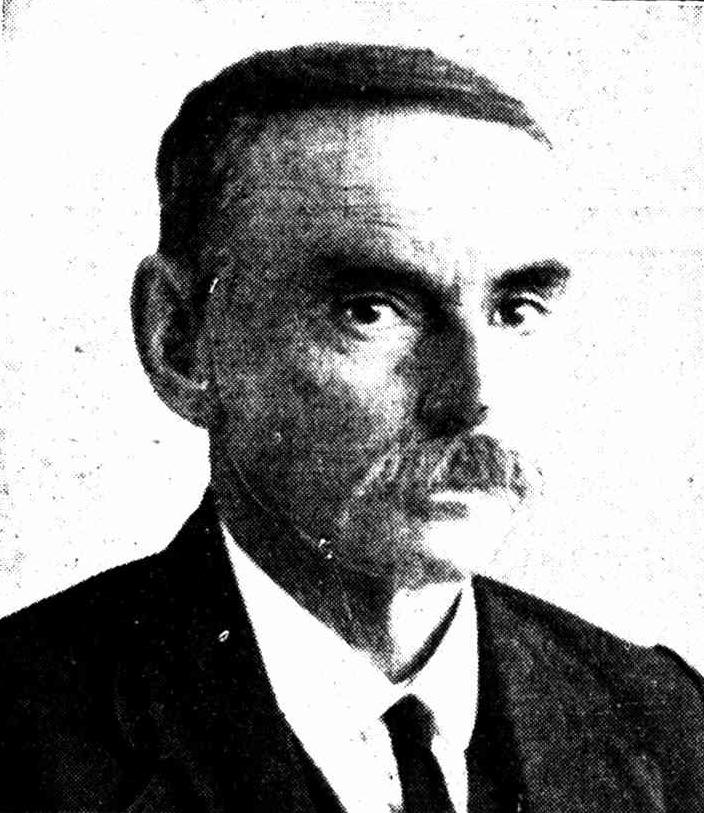
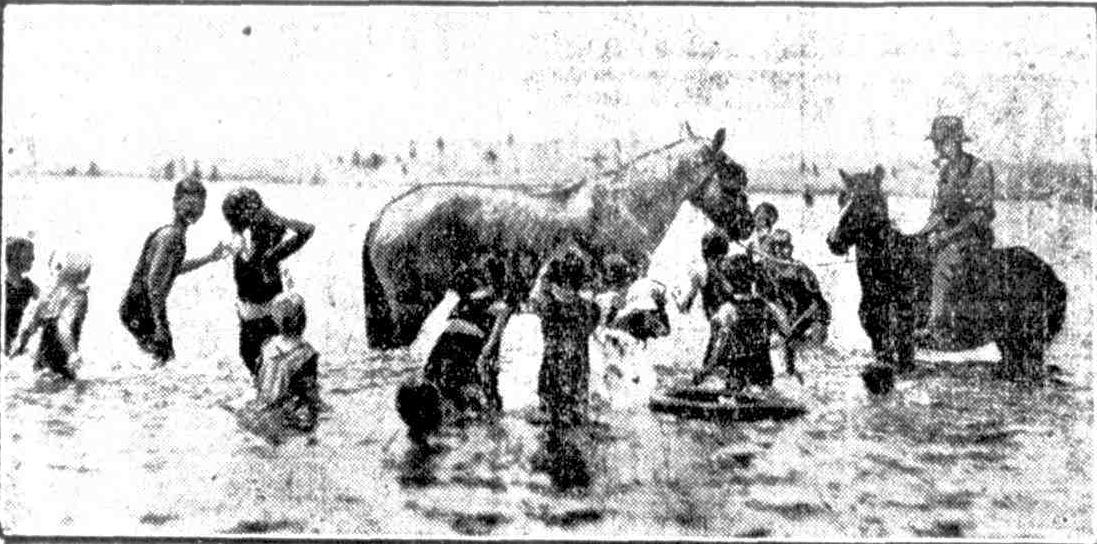
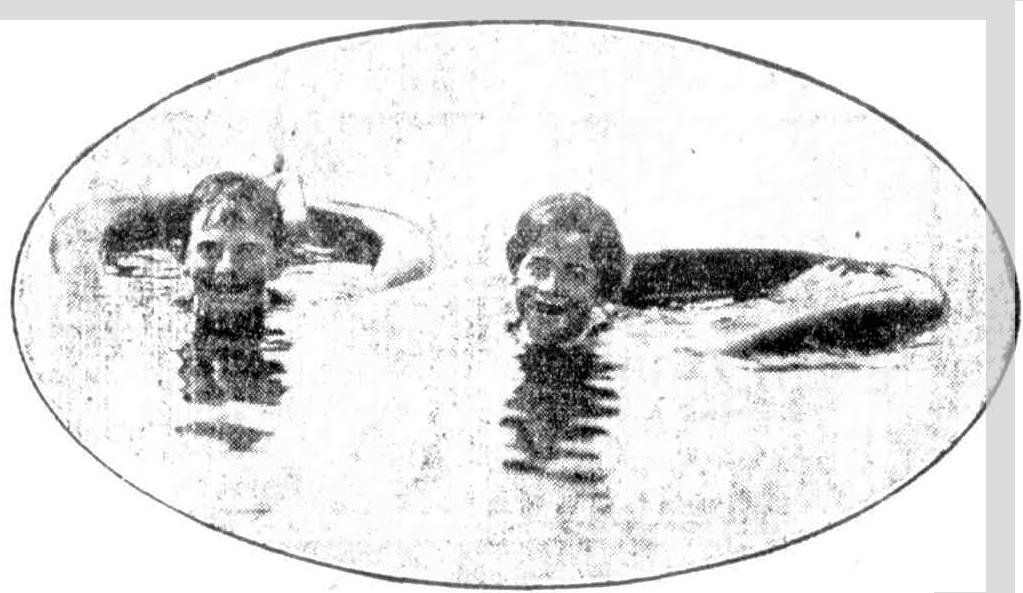
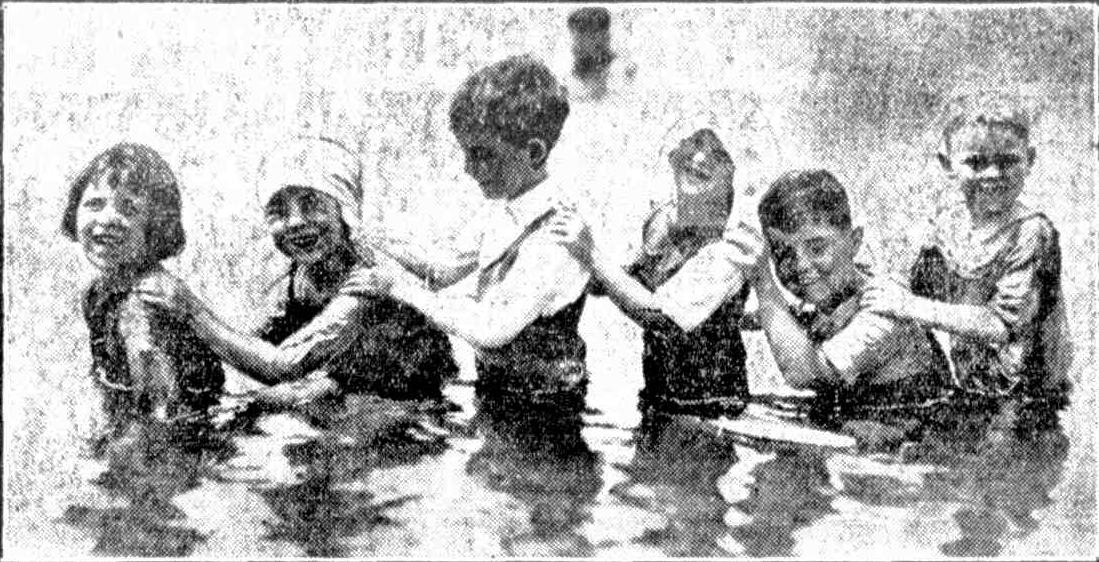
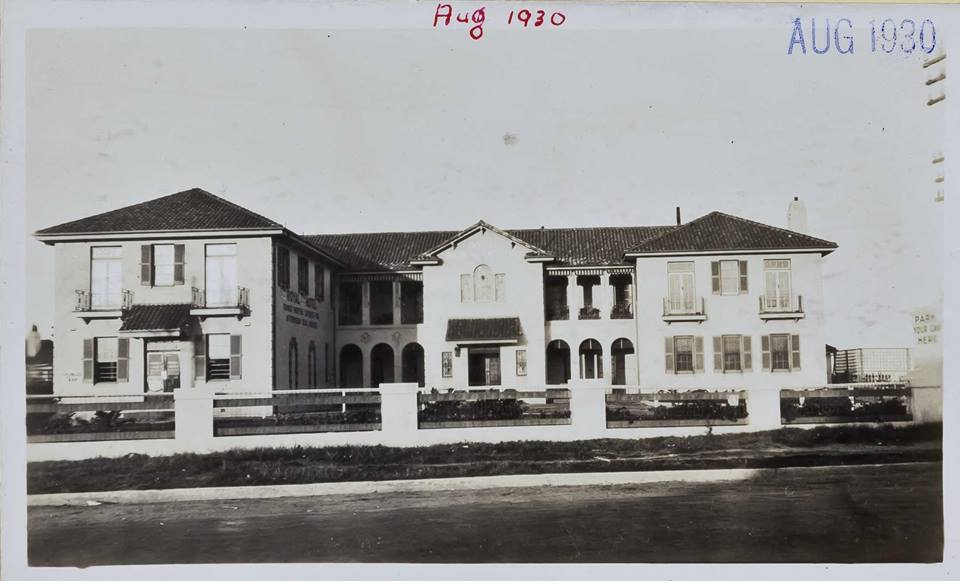
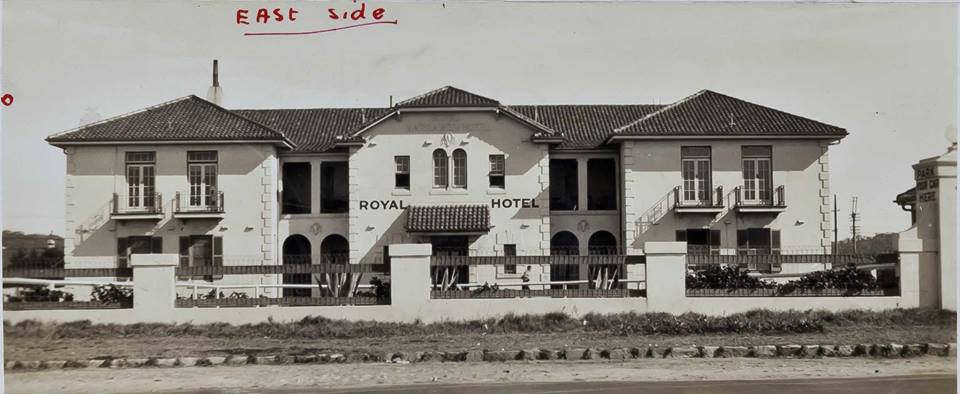
1945 Bus To Narrabeen
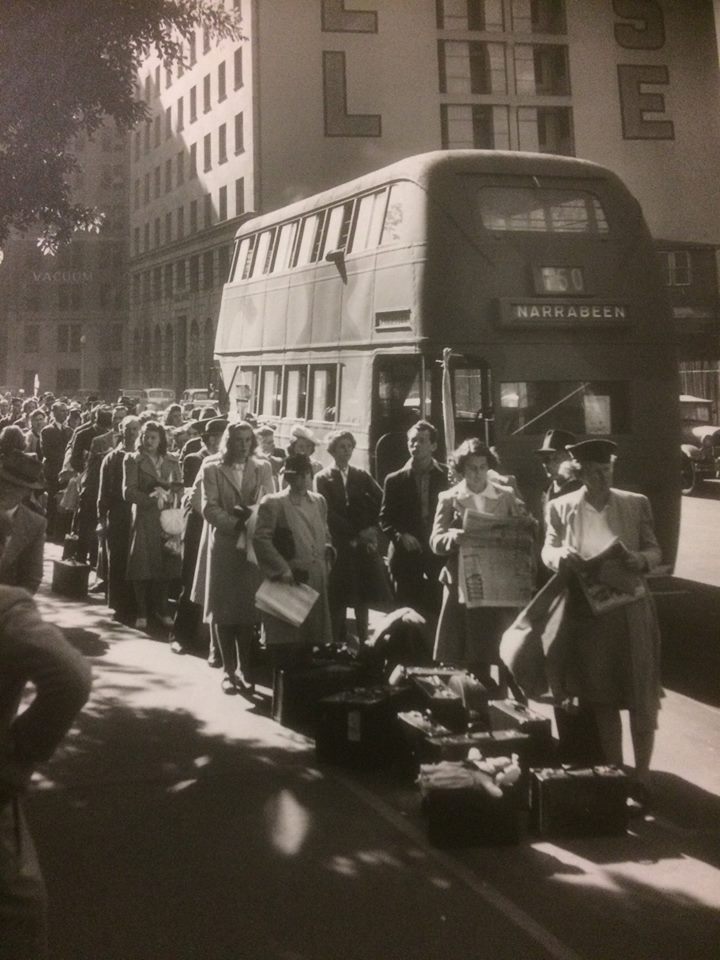
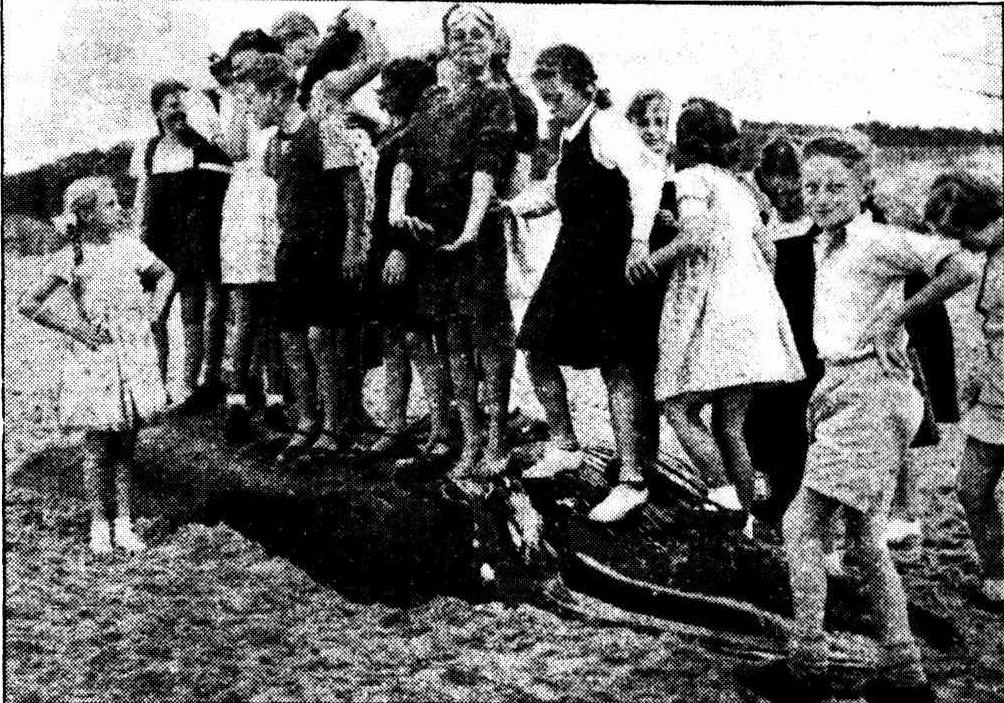
- In 1938-39, Australians drank just over 84 million gallons of beer-12.13 gallons a head.
- In 1948-49, they drank nearly 140 million gallons-17.87 gallons a head.